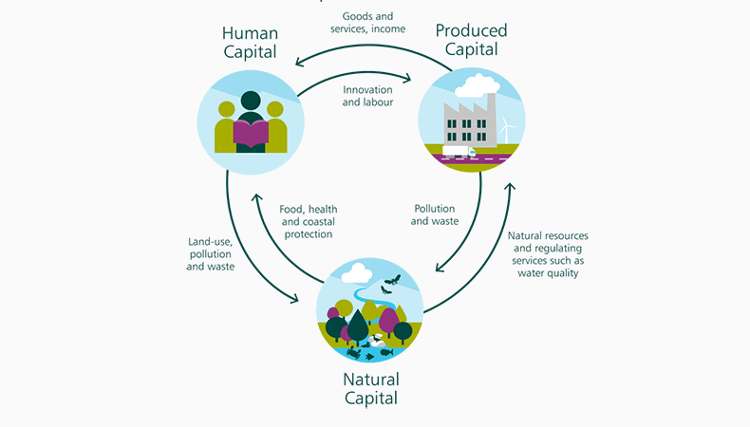Economics, industry and biodiversity

The industry needs new goals to halt the biodiversity crisis. To start with, good energy and waste management can reduce the release of pollutants into the atmosphere.
While most media attention has been on climate change, there has been another crisis building that has an equally critical need for action: loss of biodiversity. Most people will be aware that we have COP 26 on climate change taking place in November 2021 in Glasgow, but perhaps not that COP 15 on biodiversity is due the month before, in China, when governments from around the world will be meeting to set new goals for nature.
Economic growth to date has been at the expense of nature, and the cost of damaging it not properly factored in. However, in February 2021 a report was published that does exactly that: The Economics of Biodiversity: The Dasgupta Review. The report makes it quite clear that we cannot carry on the way we have been and that, at global and government level, we need to change our ways of thinking and acting. Looking after nature is not something we can dismiss as too expensive in difficult times: it’s something we can’t afford not to do. The way we operate in business needs to change too.
An uncomfortable place
The report doesn’t make comfortable reading. Nature, our ‘natural capital’, declined by nearly 40% between 1992 and 2014. Mankind’s destruction of nature undermines the ability of our planet to feed us, provide clean air to breathe, clean water to drink, food to eat and all the resources we rely on in our daily lives. We’ve also made it harder for the planet to manage the impacts of climate change and of pollution, and we’re spoiling a place of beauty that’s for us all to enjoy. Such damage increases the risk of pandemics: environmental degradation and the emergence of novel diseases or diseases newly transmissible to humans are strongly connected. And as with climate change, it is those with lower incomes who suffer most. And both issues are intertwined – climate change drives biodiversity loss and vice versa.
The interactions between humanity and nature are neatly illustrated in the diagram below, taken from the abridged version. (This version was prepared by the author for the person he calls ‘the concerned citizen’, and is less mathematical than the full version, so a good place to start if reading further. It can be downloaded here.)

From The Economics of Biodiversity: The Dasgupta Review – abridged version
The report shows how the value of our natural capital can, and must, be included into government and corporate accounting systems. Many businesses have, for some time, using the ‘triple bottom line’ of financial, social (or human) and environmental (or natural) capital to try and get the right balance, but this needs further development. To paraphrase quite a lot of pages, we need to ensure that we live off the interest, not continue using up the capital as we have been – and we also need to rebuild that capital fund by making good the damage we’ve been causing.
A very interesting approach to economics is ‘doughnut economics’, a concept created by Kate Raworth that can be applied to businesses, cities or any organisations and has two boundaries to manage: the ‘ecological ceiling’ and the ‘social foundation’. This type of regenerative economics also fits in neatly with circular economy thinking, the next topic in this series, so will be included.
First steps
Many of the changes needed to protect biodiversity are at government level, looking at policy, law and infrastructure, but there are actions for business to take. Although the biggest driver of loss of biodiversity on land is food production (and changing our diets to consume less meat and dairy can make a big difference), all industries interact with nature in many ways and have an opportunity to help protect this vital resource, and our industry is no exception. So here are a few thoughts for getting started.
Perhaps the most obvious way to protect our rivers and land, our fish, animals, plants, birds and insects, is preventing pollution.
To protect water, make sure your wastewater pipes are properly connected (you might be surprised how many misconnections there are, causing foul water and trade effluent to go straight into rivers), maintain any oil/water separators in yards or car parks and make sure no detergents are used for cleaning vehicles where water could drain into them, as that stops them working. Clean up spills so that nothing goes into surface water drains, watercourses or unpaved land other than clean rainwater; keep litter under control as well as managing waste storage to prevent rainwater becoming contaminated.
Good solvent management, boiler maintenance, vehicle and plant maintenance and energy management all go towards reducing pollutants into the atmosphere.
Another positive action to prevent overuse of nature’s resources is preventing and reducing waste and moving towards a more circular economy. This is a path that government policy is also driving us down, and there will be more about that in a future article.
Rethinking supply chains
Look to your supply chain too. The purchasing element that has the most obvious connection to biodiversity is to buy timber products (not just paper and board but building materials and furnishings) from sources certified as responsibly managed – but also think more widely. There are other direct elements, such as how any planting you have is maintained and if it supports or damages biodiversity, and more indirect issues of resource management and pollution prevention and control within goods and services you use. There are many opportunities once you start thinking that way.
At the moment, plastic bags are getting the headlines as destroyers of nature, but public awareness of biodiversity loss and pollution is rising.
Become a FESPA member to continue reading
To read more and access exclusive content on the Club FESPA portal, please contact your Local Association. If you are not a current member, please enquire here. If there is no FESPA Association in your country, you can join FESPA Direct. Once you become a FESPA member, you can gain access to the Club FESPA Portal.
Topics
Recent news

No minimum order: the growth of DTF decoration
Andy Rogers at Stahls’ UK and Europe, garment decoration firm based in Braintree, UK and Dillingen, Germany, on the cost and speed benefits of direct to film (DTF) printing.

The design democracy: AI, creativity and interior décor
We spoke to Matt Fletcher of John Mark Ltd and Cheryl O’Meara from the Print Pattern Archive about combining age-old techniques with artificial intelligence (AI) to create exciting new motifs for luxury wall coverings.

